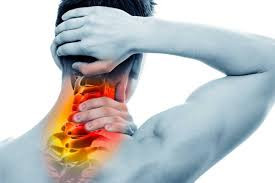Definisi
Sindrom servikal adalah kumpulan kelainan yang disebabkan oleh perubahan tulang belakang leher dan jaringan lunak di sekelilingnya. Struktur tersebut meliputi bantalan tulang belakang, sendi, otot, dan ligamen. Kondisi umum terjadi dengan nyeri sebagai gejala utamanya.
Penyebab
Penyebab tersering sindrom servikal adalah penurunan fungsi tulang belakang leher. Perubahan degeneratif ini terjadi pada sendi-sendi tulang belakang, sendi antara tulang belakang dan tulang iga, serta bantalan tulang belakang.
Selain dari proses degeneratif, sindrom servikal dapat terjadi karena beberapa penyebab, termasuk cedera (patah tulang, memar, robekan ligament), proses peradangan (rematik dan infeksi), perubahan metabolik, dan tumor.
Beberapa contoh kelainan tulang belakang leher antara lain:
- Spondilosis servikal yaitu proses penuaan dari tulang rawan dan tulang belakang leher.
- Herniasi diskus servikal yaitu penonjolan atau pecahnya diskus (bantalan) antar tulang belakang.
- Penyakit diskus degeneratif di mana diskus mengalami kerusakan dan penurunan fungsi.
- Stenosis spinal servikal di mana saluran saraf tulang belakang leher menyempit.
- Mielopati servikal yaitu kerusakan saraf tulang belakang leher akibat penyempitan saluran atau penurunan fungsi.
- Radikulopati servikal yaitu saraf yang tertekan atau terjepit.
- Infeksi.
- Tumor.
Faktor Risiko
Faktor-faktor yang dapat meningkatkan risiko terjadinya sindrom servikal antara lain:
- Duduk lama dengan posisi yang salaha tau postur bekerja yang tetap. Beban tulang belakang yang berlebihan dan tidak tepat akan mengakibatkan postur yang buruk. Akibat postur tubuh yang buruk di tempat kerja ini, tulang belakang leher serta otot-otot leher dan bahu akan mengalami stres yang hebat. Suatu studi melaporkan bahwa terdapat peningkatan risiko nyeri leher pada pekerja yang duduk lebih dari 95% waktu kerjanya dibandingkan dengan pekerja yang jarang duduk saat bekerja.
- Jenis kelamin. Wanita lebih banyak mengeluhkan nyeri leher dibandingkan pria.
- Usia paling banyak ditemukan sindrom servikal adalah pada orang berusia antara 35 sampai 49 tahun.
- Stres.
- Merokok.
Gejala
Gejala utama sindrom servikal adalah nyeri dengan intensitas yang sangat bervariasi, dari nyeri sedang sampai sangat berat. Nyeri servikal dapat menjalar ke kepala, rahang, bahu, hingga salah satu atau kedua lengan, punggung, dan bahkan tungkai. Sensasi nyeri ini merupakan kumpulan dari:
- Peningkatan ketegangan otot belakang leher.
- Kekakuan leher.
- Penurunan gerakan leher.
- Gangguan pada regio kepala yang dapat meliputi telinga berdenging, pandangan buram, nyeri kepala, pusing.
- Gangguan pada anggota gerak atas.
- Lelah.
- Gejala lain yang dapat terjadi meskipun lebih jarang adalah gangguan koordinasi atau keseimbangan, kesulitan bernapas, hilangnya kontrol BAB dan BAK.
Gejala ini dapat berkembang dari stadium akut hingga kronis. Pada fase akut, nyeri dapat terjadi dari beberapa hari sampai beberapa minggu. Jika nyeri terus ada sampai lebih dari beberapa minggu, hal ini sudah dapat dikatakan sindrom servikal kronis.
Diagnosis
Untuk mendiagnosis sindrom servikal, pertama-tama dokter akan menanyakan mengenai riwayat penyakit dan obat-obatan yang Anda konsumsi, serta gejala yang Anda alami. Setelah itu, dokter juga akan melakukan pemeriksaan fisik dan tambahan.
Beberapa pemeriksaan tambahan yang dapat dilakukan pada sindrom servikal adalah sebagai berikut:
- CT scan. CT scan dapat menunjukkan bentuk dan ukuran saluran saraf tulang belakang, isinya, dan tulang di sekitarnya. Hal ini dapat membantu mendiagnosis adanya penyakit degeneratif tulang belakang leher, peradangan, dan kerusakan tulang akibat infeksi ataupun tumor.
- MRI. Pemeriksaan ini dapat menentukan adanya masalah pada saraf tulang belakang leher dan saraf yang keluar dari tulang belakang, penyakit degeneratif tulang belakang, herniasi diskus, infeksi, dan tumor.
- X-ray. X-ray akan menampilakn gambar tulang dan jaringan lunak sekitarnya menggunakan radiasi yang kecil. X-ray dapat menunjukan adanya patah tulang, masalah pada diskus, gangguan kelengkungan tulang belakang, dan adanya peradangan sendi tulang belakang.
- Elektrodiagnostik. Pemeriksaan elektroneurofisiologis dilakukan dengan arus listrik dan elektroda untuk menentukan fungsi dan kerusakan saraf dan otot. pemeriksaan ini meliputi elektromiografi (EMG) dan studi konduksi saraf.
Tata Laksana
Beberapa pilihan terapi untuk sindrom servikal adalah sebagai berikut:
- Stimulasi saraf atau stimulasi elektrik. Terapi ini menggunakan listrik voltase rendah untuk menghentikan sinyal saraf yang menyebabkan nyeri. Contoh terapi ini adalah stimulasi saraf elektrik transkutan, di mana elektroda dipasang di kulit pada ujung-ujung saraf, dan stimulasi saraf tulang belakang di mana elektroda dipasang di bawah kulit.
- Prosedur tulang belakang. Prosedur ini dibantu dengan teknik radiologi untuk menghantarkan steroid dan obat-obatan tepat ke sumber nyeri. Hal ini akan mengurangi nyeri dan peradangan di leher. Terapi ini biasanya dilakukan bersama dengan terapi fisik atau latihan fisik.
- Penyuntikan dengan bantuan ultrasonografi. Ultrasonografi membantu dokter untuk melihat saraf, tulang, tendon, dan otot. Kombinasi ultrasonografi dengan terapi suntikan berarti dokter dapat memberikan obat ke poin nyeri yang tepat untuk memperbaiki nyeri dan peradangan. Penyuntikan steroid dan plasma kaya platelet sering digunakan untuk menangani nyeri saraf-otot-tulang.
- Ablasi radiofrekuensi. Prosedur ini menggunakan panas dari gelombang radio untuk merusak jaringan saraf, sehingga mengganggu kemampuannya untuk menghantarkan sinyal nyeri.
- Manajemen kekakuan. Terapi untuk kekakuan bertujuan untuk merelaksasi otot yang kencang dan kaku dengan obat-obatan. Terapi ini meliputi penyuntikan botulinum toxin (Botox) untuk otot yang spesifik dan penyuntikan baclofen ke dalam cairan saraf tulang belakang.
Setiap metode terapi fisik untuk sindrom servikal sudah terbukti bermanfaat. Terapi fisik yang tepat dapat membantu penderita nyeri leher untuk kembali melakukan aktivitas sehari-hari dengan normal, meningkatkan kualitas hidup, serta mengurangi hari absen dari kerja.
Komplikasi
Sindrom servikal memengaruhi fungsi fisik dan psikologis dan dapat memberikan efek negatif pada aktivitas sehari-hari. Orang yang mengalami sindrom servikal akan memiliki keterbatasan mobilitas, sehingga meningkatkan frekuensi absen kerja serta menurunkan kualitas hidup.
Pencegahan
Anda mungkin tidak dapat mencegah sindrom servikal sepenuhnya, namun terdapat beberapa cara yang dapat Anda lakukan untuk mengurangi risiko yaitu:
- Tetap aktif secara fisik
- Jaga postur duduk yang baik
- Hindari cedera leher dengan menggunakan alat yang tepat saat berolahraga
Kapan Harus ke Dokter?
Jika Anda mengalami nyeri leher atau gejala lain dari sindrom servikal, sebaiknya Anda berkonsultasi ke dokter. Dokter dapat membantu menemukan masalahnya, sehingga Anda dapat mengembalikan fungsi sehari-hari.
Mau tahu informasi seputar penyakit lainnya? Cek di sini, ya!
- dr Ayu Munawaroh, MKK
Kasumovic, M. (2013). Cervical Syndrome – the Effectiveness of Physical Therapy Interventions. Pubmed. Retrieved from http://Cervical Syndrome – the Effectiveness of Physical Therapy Interventions
System, C., System, U., Services, T., & Disorders, C. (2022). Cervical Spine Disorders. Retrieved 19 September 2022, from https://umiamihealth.org/en/treatments-and-services/physical-medicine-and-rehabilitation/cervical-spine-disorders
Cervical Spine (Neck): What It Is, Anatomy & Disorders. (2022). Retrieved 19 September 2022, from https://my.clevelandclinic.org/health/articles/22278-cervical-spine












